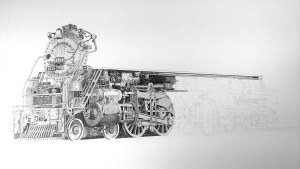 Here we are at the 70-hour mark. The bottom half of the engine is half done. The back half does not have as much detail as the front so the back will go faster. The drawing of it is complete and some inking has begun. Since the last post, a second driver is completed as well as some pipes, tubing, valves, etc. If you look in the drawing part of the back half, you can see a standing man. This shows just how big this train was.
Here we are at the 70-hour mark. The bottom half of the engine is half done. The back half does not have as much detail as the front so the back will go faster. The drawing of it is complete and some inking has begun. Since the last post, a second driver is completed as well as some pipes, tubing, valves, etc. If you look in the drawing part of the back half, you can see a standing man. This shows just how big this train was.
More history…
The Timken locomotive was completed and first fired at ALCO’s Schenectady plant in March 1930. It was painted dark green with gold stripes and trim and numbered 1111. The number led to the moniker “Four Aces.” A club, heart, diamond, and a spade appeared in the number boards on either side of the headlight and was stenciled on both sides of the sand dome. The Four Aces worked on 14 railroads between April 14, 1930 and January 4, 1932. The first was the New York Central where it logged 6,582 miles all in freight service. More than 100,300 total miles were logged on the 14 railroads – 51,655 miles in freight service and 48,664 miles in passenger service. Twelve of the 14 railroads seriously tested the Four Aces. In freight service, the locomotive made 328 freight runs pulling an average of 83+ cars per trip, an average speed 29.8 mph. On the Chesapeake & Ohio, Four Aces started and pulled a 132 car coal train weighing 9,864 tons. In passenger service, Four Aces made 227 runs with an average of almost 11 cars per trip at an average speed of 41.2 mph.
But it wasn’t all hard work during this time. On one occasion, as a publicity stunt, three men pulled the locomotive – 335 tons – back and forth on level track on the Pennsylvania Railroad. Three female secretaries did the same in Chicago. This would have been impossible to do with a solid bearing engine. The Four Aces was equipped with roller bearings on both engine trucks, drivers, and tender trucks. The engine and cab measured nearly 60 feet long, nearly 15 feet high, and about 10 feet wide. The total engine weight was 417,500 pounds (208.75 tons). The driver wheels diameter (the big ones)was 73 inches (6 feet, one inch). The boiler pressure was between 235 psi and 250 psi. The piston cylinders were 27 inches in diameter and the piston stroke was 30 inches. The top speed was designed to be 85 mph.
More later… stay tuned!

I love it, of course and I have a quick question… what is the wishbone looking pen lines in the front?
Gina, to be honest, I’m not sure. They appear to be cables for something. I’m thinking it may be something that is needed if it needs a “helper” engine to help it with a load. Sometimes if there is a heavy load to move, they would (and still do) hook another engine to help it.